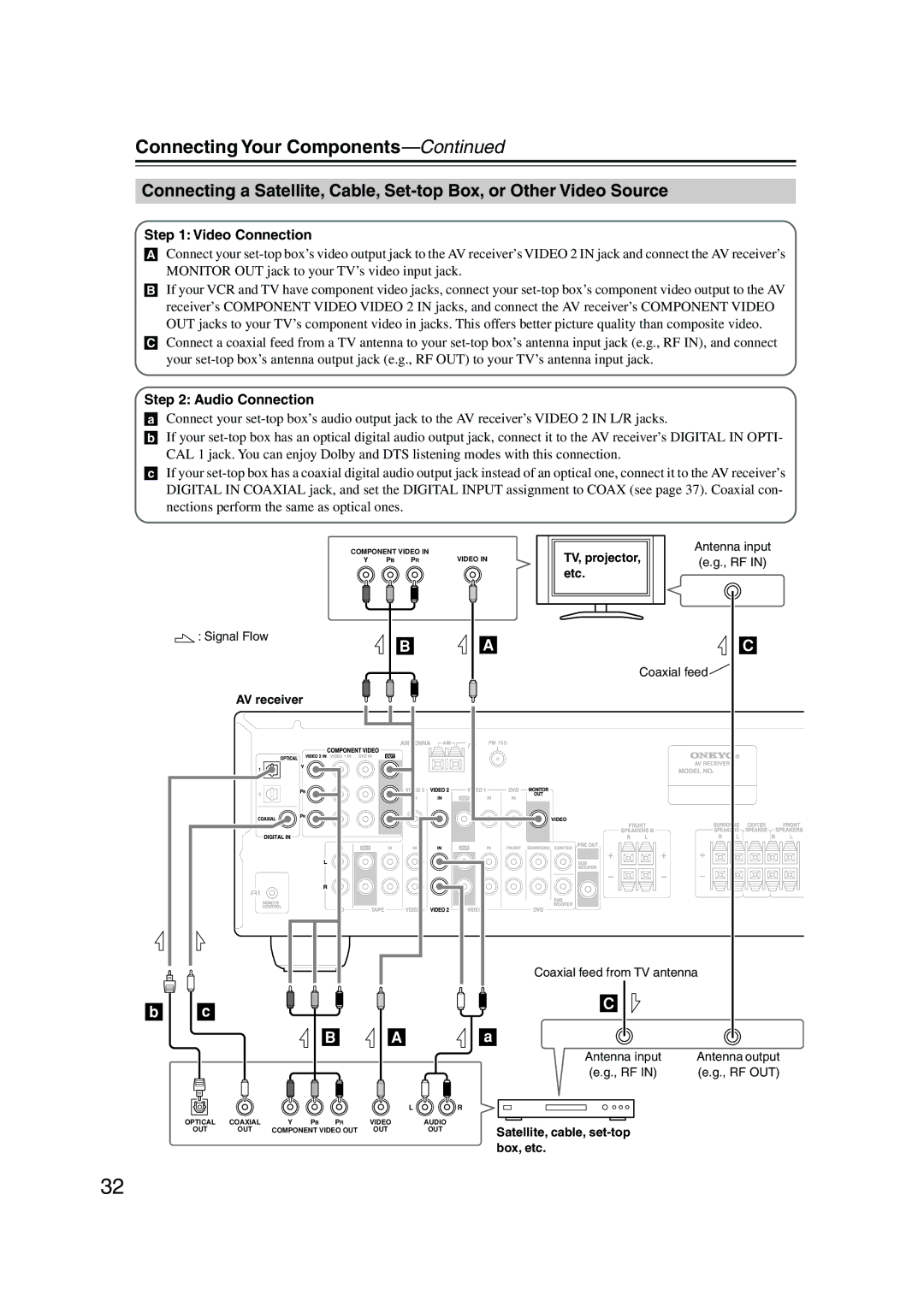HT-S4100
Important Safety Instructions
Avis
FCC Information for User
Precautions
Power
Speaker Precautions
Precautions
Placement
Using Close to a TV or Computer
Features
AV Receiver TX-SR304
Speaker Package HTP-460
RI Dock DS-A1XP
Contents
Package Contents
Package Contents
Front & Rear Panels
Front Panel 6 78 9JK
Front & Rear Panels
Display
Rear Panel
K L M
Subwoofer SKW-460
Using the Floor Pads
Speakers
Receiver Mode
Remote Controller
How to Use the Remote Controller
Remote Controller
DVD Mode
CD Mode
To select your CD player as the input source, press
MD, & CDR Mode
CDR
HDD Mode
Album +/- button
Playlist / buttons
MENU, ENTER, and Up and Down / buttons
Tape Mode
Play button
Stop button
Reverse Play button
Using the Remote Controller
Before Using the AV receiver
Installing the Batteries
Enjoying Home Theater
Speaker Sets a and B
Speaker Set a Main Room
Speaker Set B Sub Room
Speaker Configuration
Connecting Your Speakers
Speaker Connection Precautions
Connecting a Powered Subwoofer
Connecting Your Speakers
Connecting Speaker
Using Speaker Mounts/Brackets
Using the Rubber Stoppers for a More Stable Platform
Wall Mounting
Front speaker SKF-360F Surround speaker SKM-360S
Connecting Antenna
Connecting the AM Loop Antenna
Connecting the Indoor FM Antenna
Other Models
Connecting Antenna
Connecting an Outdoor FM Antenna
Connecting an Outdoor AM Antenna
Using a TV/FM Antenna Splitter
Connecting Your Components
About AV Connections
Optical Digital Jacks
AV Connection Color Coding
Connecting Your Components
Connecting Both Audio & Video
Which Connections Should I Use?
Video Connection Formats
Connecting a DVD Player
Video Connection DVD Player to AV Receiver to TV
Audio Connection
Multichannel Audio Connection
Video Connection VCR to AV Receiver to TV
Connecting a VCR
Connecting a VCR for Playback
Video Connection
Connecting a Camcorder, Games Console, or Other Device
Connecting a VCR for Recording
RF OUT
Connecting a CD Player or Turntable
CD Player or Turntable with Built-in Phono Preamp
Connecting the DS-A1XP RI Dock for the iPod Audio Only
Connecting a Cassette, CDR, MiniDisc, or DAT Recorder
Connecting Onkyo Components
Connecting the Power Cord
Auto Power On/Standby
Remote Control
Turning On
Turning On the AV Receiver
Smooth Operation in a Few Easy Steps
Have you connected a component to a digital audio input?
Changing the Input Display
First Time Setup
Assigning Digital Inputs to Input Sources
First Time Setup
Press the Setup button
Testing the speakers
Use the Down Button to
Left and Right Buttons to Select Small, Large, or None
Select a suitable listening mode and enjoy
See Using the Listening Modes on
Playing Your AV Components
Basic AV Receiver Operation
Displaying Source Information
Using the Multichannel Input
Playing Your AV Components
Listening to the Radio
Using the Tuner
Tuning into Radio Stations
Using the Tuner
Presetting Radio Stations
Deleting Presets
Selecting Preset Stations
DS-A1XP RI Dock for the iPod
Adjusting the iPod Adapter
Using Your iPod’s Alarm Clock
Charging Your iPod’s Battery
DS-A1XP RI Dock for the iPod
Using Headphones
Setting the Display Brightness
Adjusting the Bass & Treble
Common Functions
Using the Sleep Timer
Press the remote controller’s Muting button
Common Functions
Muting the AV Receiver
Adjusting Speaker Levels
Headphones
Speaker Set B
Multichannel DVD Input
Using the Listening Modes
Selecting with the Remote Controller
Selecting Listening Modes
Selecting on the AV receiver
Using the Listening Modes
About the Listening Modes
Onkyo Original DSP Modes
DTS
DTS
Input Channel Settings
Adjusting the Listening Modes
Using the Audio Adjust Functions
Adjusting the Listening Modes
Using the Late Night Function Dolby Digital only
Using the CinemaFILTER
PL II Music Mode Settings
Recording from Different AV Sources
Recording
Recording the Input Source
Advanced Setup
Advanced Speaker Settings
Crossover Frequency
Double Bass
Speaker Levels
Advanced Setup
Speaker Distance
Digital Input Signal Formats
Input Selector
Press the Receiver Remote Mode button
Correcting Sound and Picture Sync
Troubleshooting
Troubleshooting
AV receiver’s remote controller doesn’t control your iPod
Sound changes when I connect my head- phones?
There’s no sound
Can’t record?
Specifications
Specifications
1ch Home Theater Speaker Package
Onkyo U.S.A. Corporation
Onkyo China Limited

